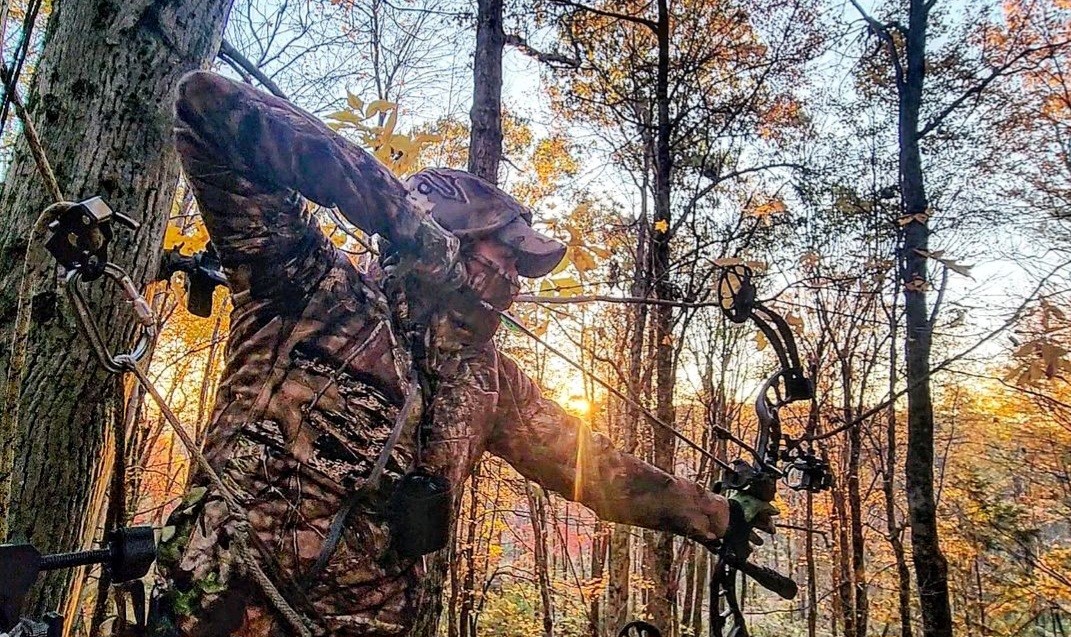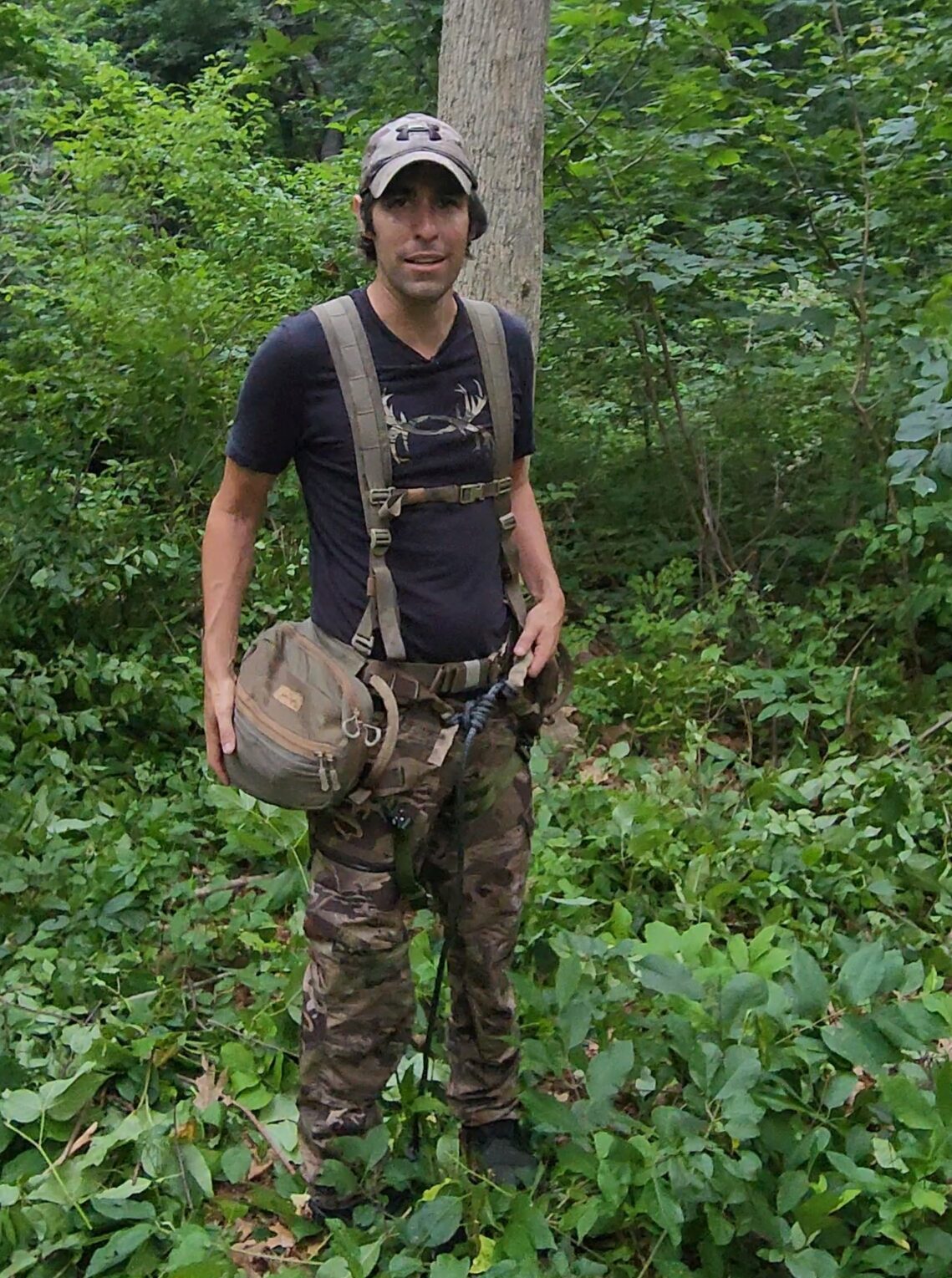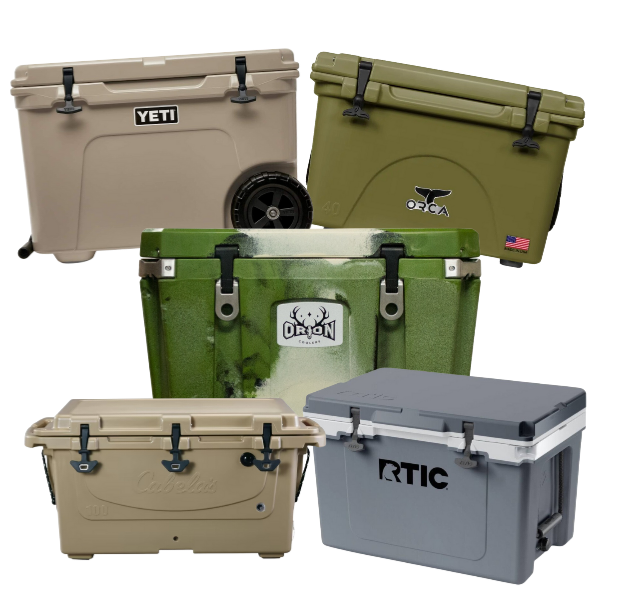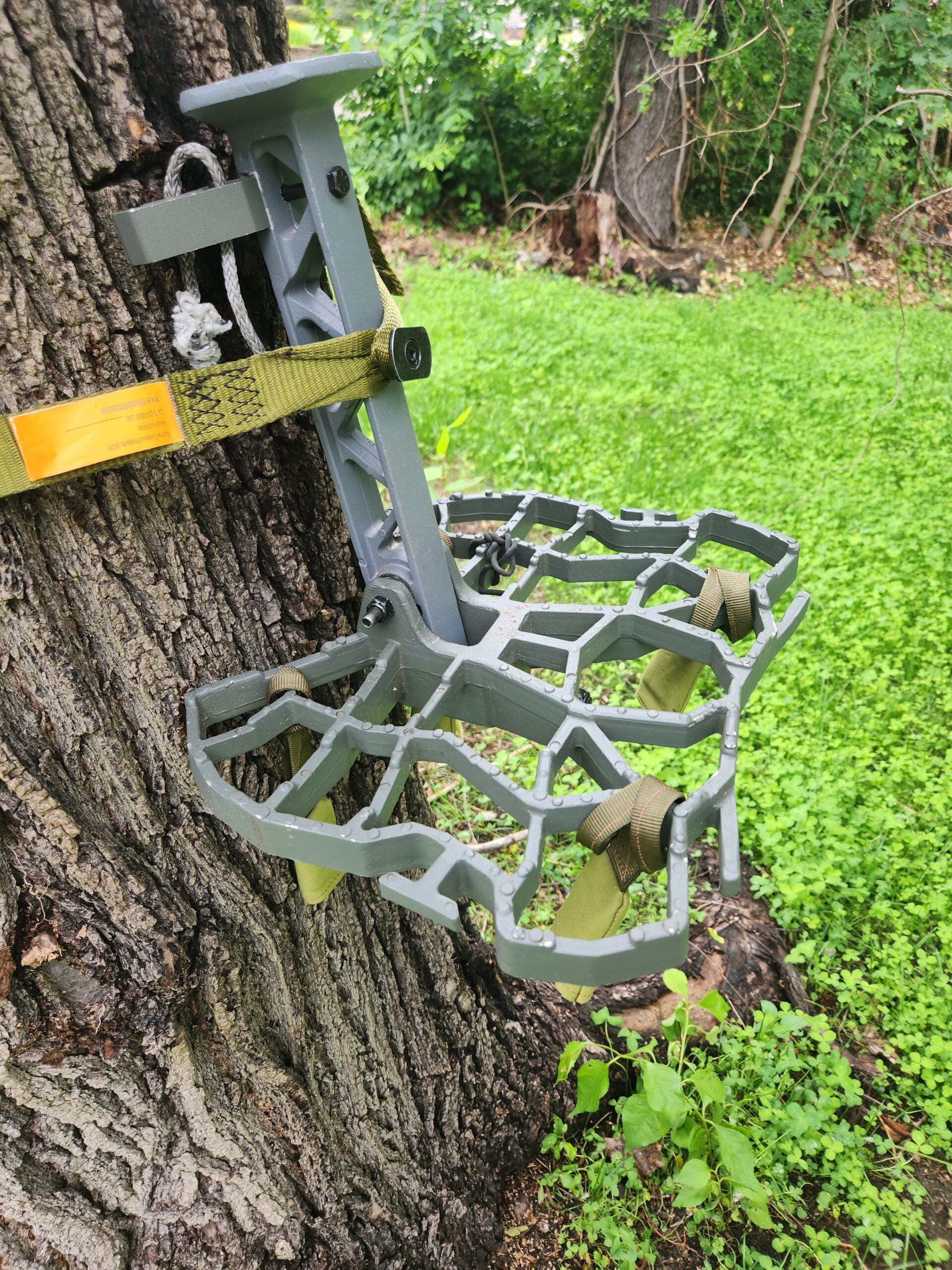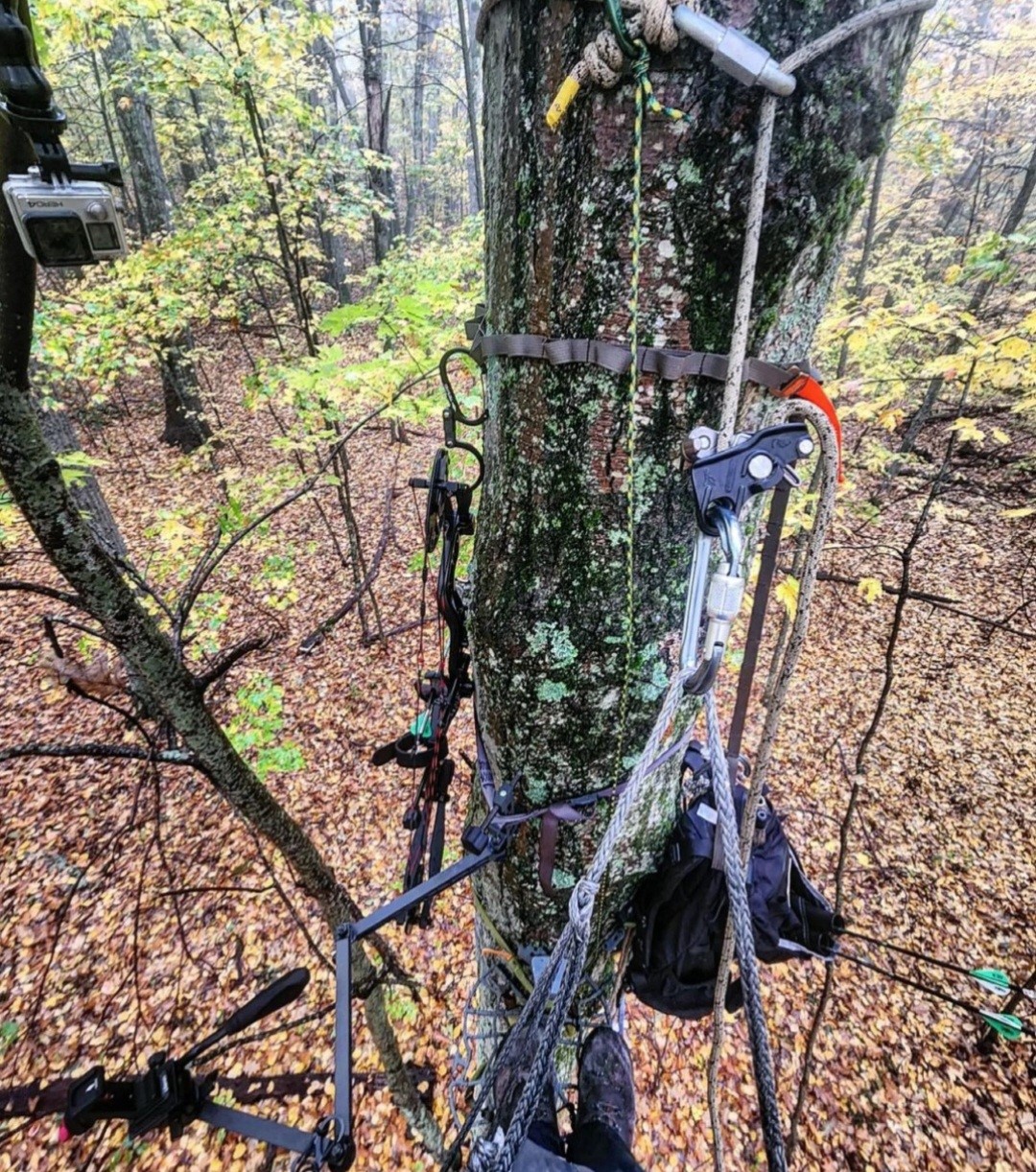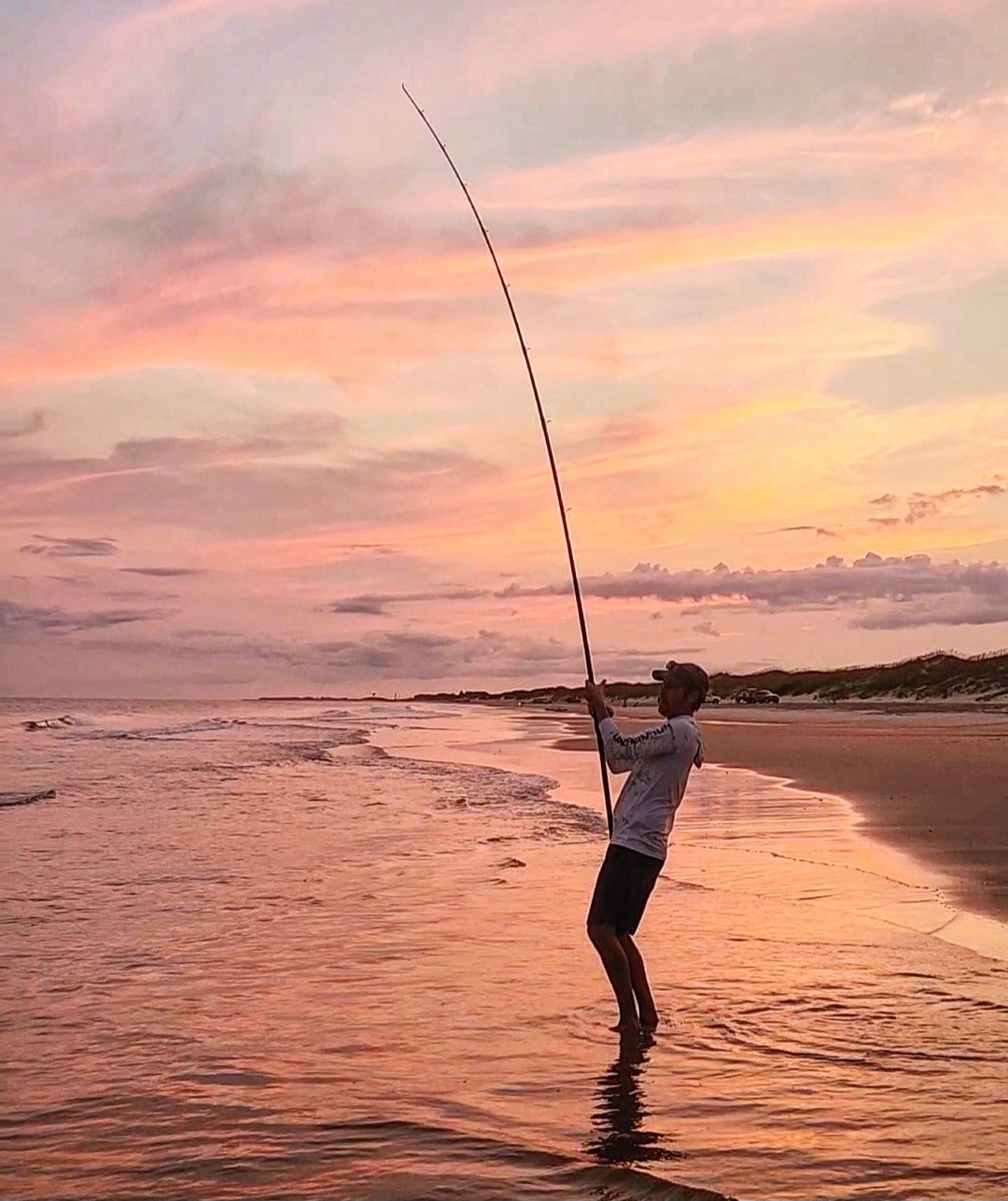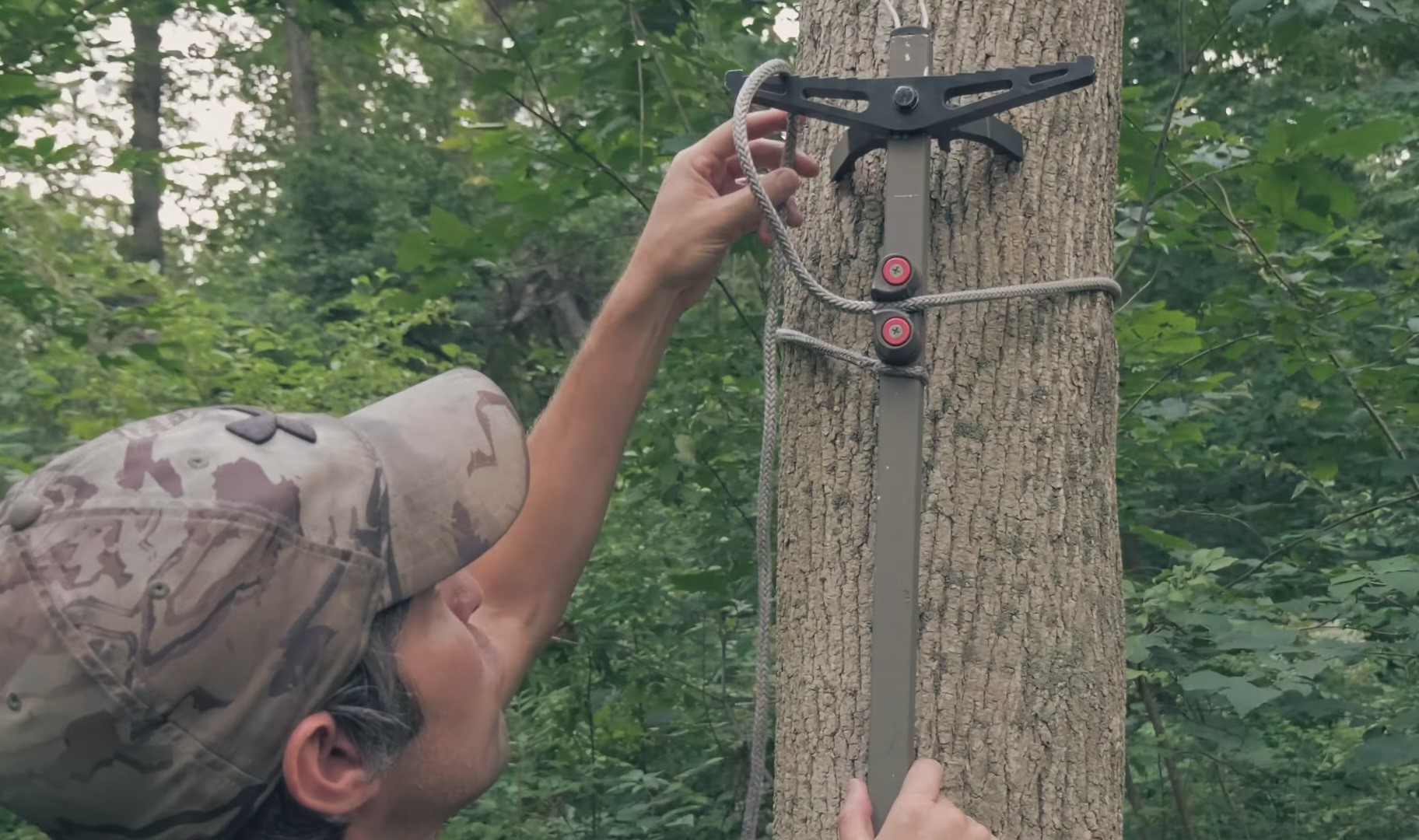
Have you ever wondered how to elevate your hunting experience and gain increased mobility while preserving safety? Look no further than the one-stick method for saddle hunting. I’m going to walk you through the step-by-step process of building your very own one-stick, allowing you to enjoy the benefits of this game-changing technique as well as how to climb and rappel down a tree.

Saddle hunting has been gaining popularity among outdoor enthusiasts due to its versatility and low-impact approach. The one-stick method takes it a step further by providing hunters with enhanced mobility and convenience. By utilizing a single climbing stick, you can climb and rappel down trees swiftly and silently, opening up new possibilities in your hunting strategy.
In this article, we will look into the details of one-stick saddle hunting, including its key characteristics compared to traditional methods. We will also address crucial safety considerations that every hunter must be aware of before engaging in this technique. Additionally, we’ll provide a comprehensive list of essential gear needed for successful one-stick saddle hunting adventures.

The heart of this guide lies in our detailed step-by-step instructions on how to build your own one-stick including a video demonstrating how to make one. From selecting the right materials to incorporating innovative techniques shared by experienced hunters, we’ll equip you with all the knowledge necessary to create a sturdy and reliable tool fit for any hunt.
But it doesn’t stop there! We will also guide you through mastering the art of using a one-stick for saddle hunting effectively. With valuable tips and insights from experts who have honed their skills over time, you’ll quickly become proficient in navigating trees safely and quietly.
To wrap things up, we’ll examine both the advantages and challenges associated with one-stick saddle hunting, allowing you to make an informed decision about integrating this technique into your own outdoor pursuits.
So grab your tools and let’s embark on an exciting journey towards enhancing your hunting experience with a DIY one-stick. Get ready to elevate your mobility, embrace new hunting strategies, and make unforgettable memories amidst the beauty of nature.

Understanding One-Stick Saddle Hunting
Before diving into the process of building your own one-stick, it’s essential to have a clear understanding of what one-stick saddle hunting entails and how it differs from traditional hunting methods.
One-stick saddle hunting is a technique that revolutionizes the way hunters climb and get down trees. Instead of using multiple climbing sticks or ladders, a single climbing stick is utilized for increased mobility and convenience. By relying on this minimalist approach, hunters can enjoy enhanced maneuverability in the field while minimizing their gear load. Hunters then use a long rope to rappel out of the tree when the hunt is over.
Another advantage of this technique lies in its versatility. Whether you prefer moving frequently during a hunt or need quick access to different areas within your hunting grounds, carrying and utilizing just one stick dramatically increases your effectiveness in navigating various terrains.
In the next section, we will look into the necessary equipment needed for successful one-stick saddle hunting adventures.
Essential Gear for One-Stick Saddle Hunting
To embark on your one-stick saddle hunting journey, it’s crucial to have the right gear and equipment that will ensure a safe and successful experience. Here is a list of essential items you will need:

- Climbing Stick: While there are various options available in the market, for building your own one-stick, an API climbing stick or similar brand is recommended. These lightweight and sturdy sticks provide excellent stability and versatility.
- Cam Cleat: A cam cleat is an important component of the one-stick setup as it allows for quick adjustment and secure attachment of your ropes while climbing. Ensure you select a durable cam cleat that can withstand repeated use.
- Rope: High-quality rope is critical for both safety and functionality during one-stick saddle hunting. Consider using Sterling rope or similar brands, known for their strength, durability, and low stretch properties.
- Aiders: Aiders are straps with steps that aid in ascending trees by providing footholds as you climb up your stick. Two-step aiders made from Amsteel rope are commonly used in one-stick setups.
- Tethers or Ropes: Tethers or ropes are essential for securing yourself to the tree while climbing up or descending down using the one-stick method. Choose reliable ropes with adequate strength to support your weight.
- Miscellaneous Items: Other important items include loopable gear ties, elastic cords, paracord, and any additional hardware that may be required for attaching various components together securely.
As you gather your gear, it’s crucial to carefully inspect each item before use to ensure they are in optimal condition. A well-maintained and reliable equipment setup is vital for a safe and successful one-stick saddle hunting experience.
With the right gear at your disposal, you’ll be ready to move on to the next section where we’ll guide you through the step-by-step process of building your own one-stick using these essential components.
Building Your Own One-Stick for Saddle Hunting
Building your own one-stick is an exciting and rewarding endeavor that will provide you with a customized tool tailored to your specific hunting needs. Follow the step-by-step guide below to construct a sturdy and reliable one-stick:

- Gather Your Materials: Before getting started, ensure you have all the necessary materials at hand. This includes an API climbing stick or similar, a cam cleat, high-quality rope (such as Amsteel),aiders, tethers/ rappel ropes.
- Inspect Your Climbing Stick: Check your climbing stick for any damage or defects that could compromise its strength and stability. Ensure it is in excellent condition before proceeding. If you use an API stick cut it down to the preferred length that you want. Generally 17-18 inches is a good length between steps.
- Prepare the Harken Cam Cleat Attachment: Begin by replacing the existing attachment on your climbing stick’s versatile button with the cam cleat. Drill two holes using the template provided with the Harken cam cleat. Use appropriate grade nuts and bolts such to securely position and fasten the cam cleat onto the stick. Depending which way you attach the Harken cam cleat will determine which way you will always deploy the rope around the tree.
- Install Amsteel Rope. Slide eye of rope down the stick. A 7.5ft finished length, 3/16″ full bury Amsteel rope is used with the Harken 150 cam cleat. Rope has a tight eye designed to slide over a 1″ tube such as the Api climbing stick that I use. It can also be girth hitched if used with a Hawk Helium or Shikar stick. Finish with a stopper knot.
- Construct Aiders: Using Amsteel rope (around 1/8 inch), create two-step aiders by measuring out segments of equal length for each step—usually around 17 inches long—and forming tight loops using locking brummel knots or other suitable techniques. I personally use the two step UltimAider that’s available on online. It’s fully adjustable allowing you to set the steps at the exact distance apart you want.
- Attach Aiders to Climbing Stick: Connect each aider securely to designated spots on your climbing stick using girth hitch knots or other recommended methods for optimal stability during ascents. The UltimAider fits securely on the bottom step of an Api climbing stick.
- Loop Handle for Top of Stick. On the top of your climbing stick you will want to add a loop of sorts allowing you to grab the stick to move up to the next position while climbing. I use coated picture hanging wire. It allows it to keep its shape but still pliable enough to bend it. Gear ties will also work.
- Prepare Tethers/Ropes: Cut lengths of high-quality rope according to your desired tethering length requirements while factoring in safety considerations such as securing yourself to the tree when ascending or getting around branches using the one-stick technique. Generally speaking an 8ft rope should do the trick.
- Secure Additional Components: Utilize loopable gear ties, elastic cords, paracord, or other suitable means to secure loose ends, prevent tangling or noise-causing movements of the ropes/gear that can alert game deer during hunts.
By following these step-by-step instructions and leveraging your creativity as needed, you’ll be able to craft a sturdy and effective one-stick tailored specifically for your saddle hunting adventures. Remember always to prioritize safety throughout the construction process and double-check each component’s reliability before stepping into the field.
In the next section, we will guide you through utilizing your newly-built one-stick effectively in saddle hunting scenarios—mastering the technique for improved mobility and success.
The One-Stick Saddle Hunting Technique
Now that you have successfully built your own one-stick, it’s time to master the technique of using it effectively for saddle hunting. Follow the step-by-step guide below to make the most out of your one-stick setup:
- Choose an Ideal Tree: Select a suitable tree that provides a clear line of sight and meets safety requirements for climbing. Look for sturdy branches and check for any potential hazards or obstacles.
- Attach Tethers/Rappel Rope Correctly: Connect your tethers/rappel rope securely to both your bridge and the designated attachment points on the tree, ensuring they are snug and on correctly.
- Test Stability: Test the stability of your climbing stick by applying downward pressure to set the climbing stick to ensure it is firmly anchored before placing weight on it.
- Ascend Using Aiders: Place one foot in each aider loop as you climb and utilize them as stepping platforms while moving upward along with the climbing stick. Keep your toes facing the middle of the tree at all times when using an aider. If you DO NOT do this the aider will kick out on you causing you to fall.
- Maintain Three Points of Contact: Always maintain three points of contact when ascending—two feet on aiders/climbing stick steps, and one hand holding onto either raiders or the step of the climbing stick for added stability.
- Reposition Your Stick: As needed, place all your weight into your saddle and tether, and reach down and unhook your one-stick from its current position and reattach it at a higher point on the tree by securing it using the Harken cam cleat. The loop you created earlier will make this process easier to reach down and grab your stick.
- Repeat Until Desired Height is Reached: Continue ascending by repeating steps 5-7 until you reach your desired height for hunting purposes or scouting vantage points alike.
- Ensure Secure Positioning: Once you’ve reached your desired height, ensure that your climbing stick is securely fixed in place before shifting your focus to hunting or observation. At this point I set up my XOP Edge platform to hunt from while others may use the one stick to hunt off of.
- Movement and Adjustments: Utilize the flexibility of your one-stick setup to freely move around the tree as necessary for optimal positioning during hunts while maintaining safety precautions at all times.
- Descend Safely: When it’s time to descend this is where the fun starts. If you did not climb using your rappel rope it’s time to switch over to it while still being connected to your tether. This allows for constant connection to the tree and safety at all times. This is why one sticking is considered one of the safest ways to hunt. At no point are you ever not connected to the tree. Now rappel down the tree using a madrock safeguard.
By following these step-by-step instructions and integrating best practices, you’ll quickly become proficient in utilizing the one-stick technique for saddle hunting. Remember to practice ascending and descending using your one-stick setup in controlled environments first before taking it out into actual hunting scenarios. Make all the steps become second nature from practicing so much.
In the next section, we will discuss both the advantages of one-stick saddle hunting and highlight some potential disadvantages and challenges that come with this technique.
Pros and Cons of One-Stick Saddle Hunting
As with any hunting technique, one-stick saddle hunting comes with its own set of advantages and disadvantages. Understanding these can help you make an informed decision about whether this method aligns with your hunting style and preferences.
Advantages of One-Stick Saddle Hunting
- Enhanced Mobility: The one-stick technique offers increased mobility and flexibility, allowing you to quickly adapt to changing hunting conditions or move to different locations without the need for bulky equipment.
- Minimalist Approach: By utilizing a single climbing stick, you reduce the overall weight and gear load compared to traditional ladder stands or multiple-climbing-sticks setups, making it easier to navigate through dense terrain.
- Low Impact on Trees: With a one-stick setup, you minimize permanent markings on trees as opposed to more invasive hunting methods such as screw in steps. This approach reduces environmental impact and preserves the natural habitat.
- Quiet Ascents and Descents: Using a one-stick enables silent movements during climbs and descents, minimizing noise that could disturb game animals in their natural habitat—increasing your chances of successful hunts.This is by far one of the biggest advantages for me.
- Cost-Effective Solution: Building your own one-stick is generally more cost-effective than purchasing pre-made climbing systems, helping you save money while still enjoying the benefits of enhanced mobility.
Disadvantages and Challenges of One-Stick Saddle Hunting
- Skill Development Required: Fully mastering the techniques involved in using a one-stick setup may require some practice before feeling comfortable with ascending, descending, and moving around trees safely.
- Risk Factors: Like any elevated activity associated with hunting, there are inherent risks involved. It’s essential to prioritize safety and take proper precautions when using a one-stick setup to prevent accidents or falls.
- Equipment Adaptations: Building your own one-stick may require modifications or adjustments depending on the specific climbing stick models and components chosen. Ensuring everything fits properly and functions seamlessly may require additional time and effort.
Despite these potential challenges, many hunters find that the benefits of one-stick saddle hunting outweigh the drawbacks—especially those seeking increased mobility, low-impact approaches, and quieter ascents/descents during their hunts.
Conclusion
In conclusion, building your own one-stick for saddle hunting can significantly enhance your overall experience in the field. By understanding the principles behind this technique, ensuring proper safety measures, gathering the necessary equipment, and following our step-by-step guide for construction and utilization, you’ll be well-equipped to enjoy the benefits of increased mobility while minimizing environmental impact.
Remember that practice makes perfect when it comes to utilizing a one-stick setup effectively. Take time to hone your skills through controlled climbs before heading out into actual hunting scenarios. With dedication and experience, you’ll master this game-changing technique that offers new possibilities in pursuing your passion for outdoor adventure.
So embrace the challenge of building your personalized one-stick setup, explore new terrain with ease and stealthiness—and most importantly—enjoy unforgettable moments as you connect with nature in ways previously unimagined. Happy hunting!
FAQ
- Is building my own one-stick difficult? Building your own one-stick requires some DIY skills, but with the right instructions and tools, it can be accomplished by most hunters.
- How much does it cost to build a one-stick? The cost of building a one-stick can vary depending on the materials you choose, but it’s generally more affordable compared to buying pre-made climbing systems esp.
- Can I use any type of climbing stick for building a one-stick? While there are different brands and models available, it’s best to select climbing sticks that are known for their stability and durability, such as API.
- Do I need prior experience in saddle hunting or tree climbing? Having some knowledge or experience in saddle hunting or tree climbing techniques can be advantageous when building and using a one-stick setup. However, beginners can also learn through proper training and practice.
- Can I modify the construction steps based on my preferences or equipment availability? Yes, you can make modifications based on your specific needs and available equipment as long as they don’t compromise safety or structural integrity.
- How do I ensure my safety while using a one-stick setup? Prioritize safety measures such as properly inspecting gear before each use, wearing a quality hunting saddle, maintaining three points of contact while ascending and staying attached to the tree via a tether or rappel rope.
- What advantages does a one-stick offer over traditional multiple-climbing stick setups? A one-stick setup provides enhanced mobility, reduces gear load, and allows for quieter ascents and descents during hunts.
